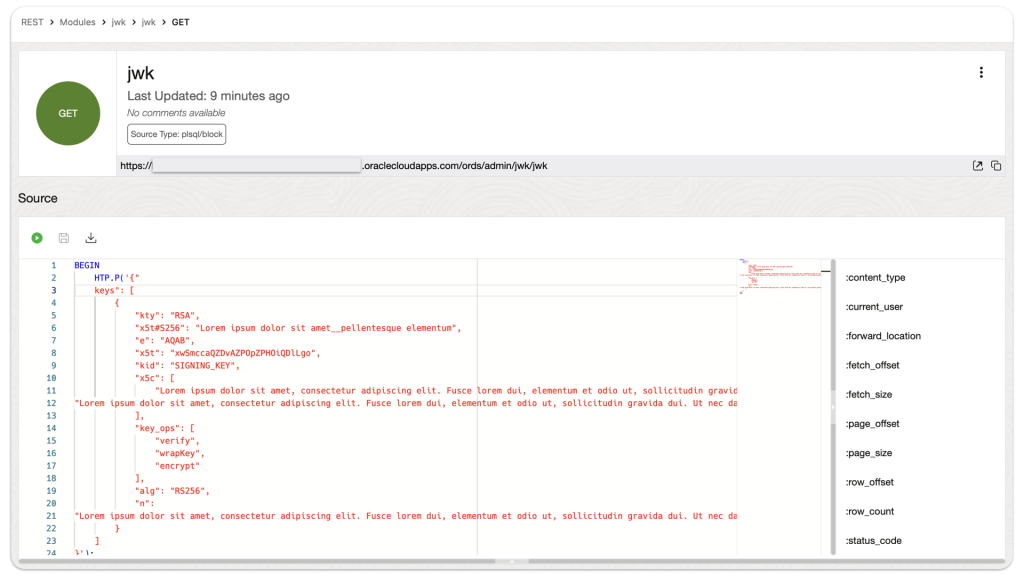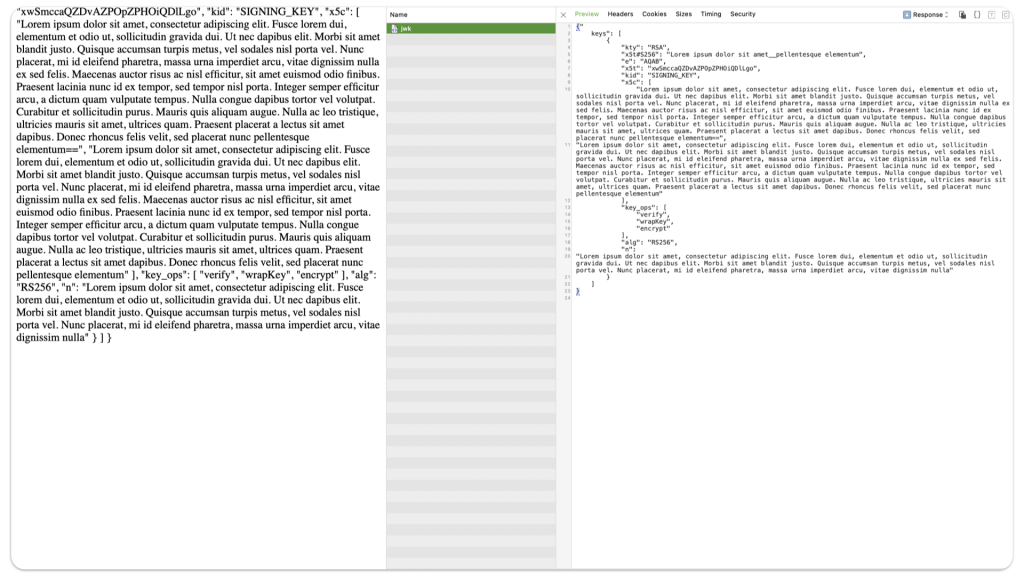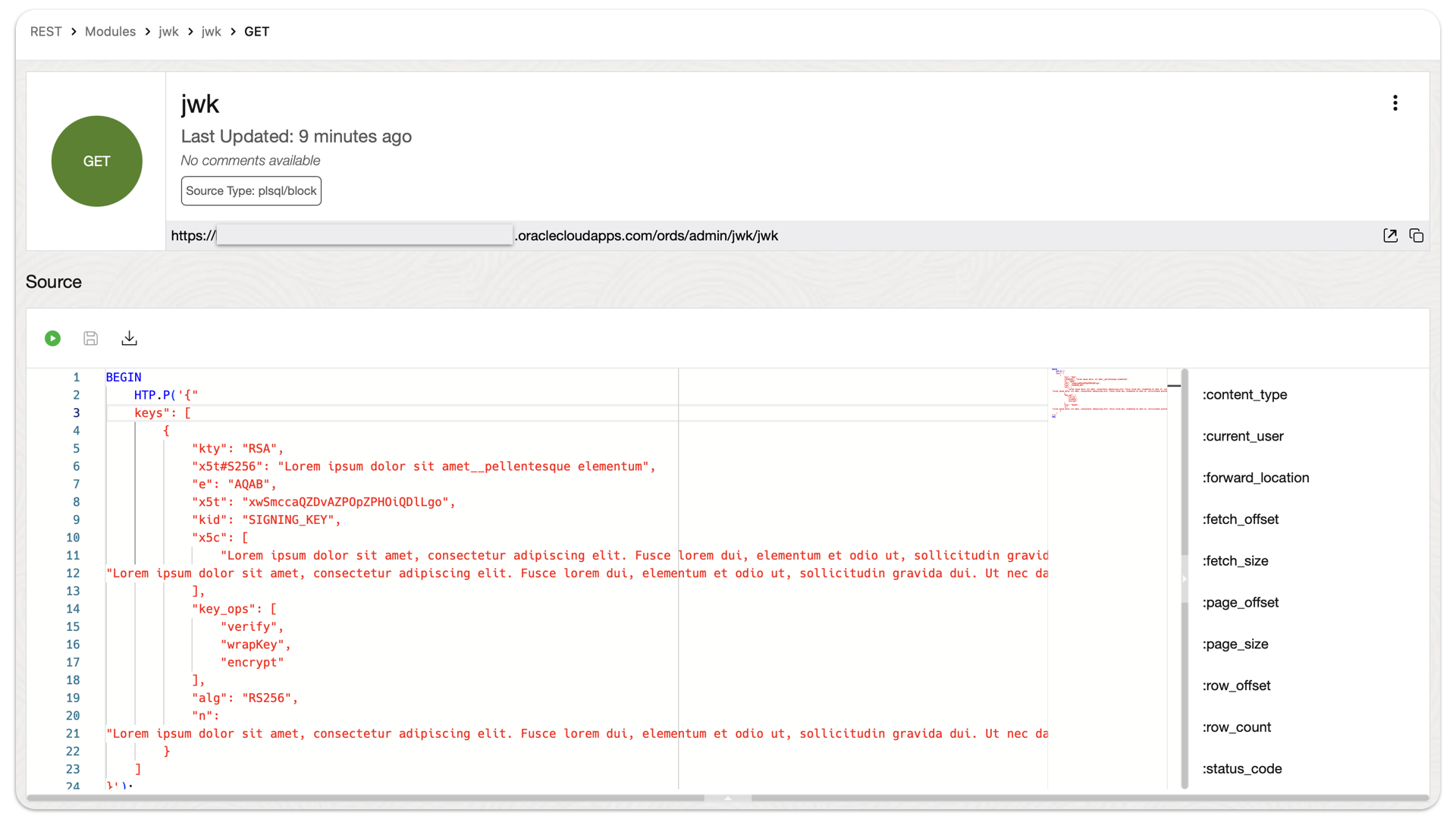This actually came about from a Support Request. We were troubleshooting a JWT issue, that had ORDS in the mix. Ultimately, this is looking more and more like a networking issue (maybe something to do with routing rules between the load balancer and the backend server).
But in the course of our troubleshooting, we wanted to rule out some variables. One of those variables was the JWK URL we were using for the ORDS_SECURITY.CREATE_JWT_PROFILE procedure. So we had this idea to kind of fool ORDS into thinking it was visiting the IDCS (the predecessor to Oracle IAM) JWK URL when, in fact, it was just visiting another ORDS endpoint.
Obvious disclaimer: NOT FOR PRODUCTION USE. For troubleshooting purposes only. This article just serves as an example of how you can build TONs of ORDS APIs without always having to create a table, JSON collection, function, procedure, view, etc…
If you’ve seen my JWT + ORDS tutorials (one for OCI IAM, another for Microsoft Azure), then you know when you create an ORDS JWT Profile, it will look something like this:
BEGIN
ORDS_SECURITY.CREATE_JWT_PROFILE(
p_issuer => 'https://identity.oraclecloud.com/',
p_audience => 'my_primary_audience' ,
p_jwk_url =>'https://idcs-10a10a10a10a10a10a10a10a.identity.oraclecloud.com/admin/v1/SigningCert/jwk'
);
COMMIT;
END;
/In the above code block, just know that p_issuer is your Identity Provider (e.g., IAM, IDCS, Microsoft Entra, etc.), p_audience is the Primary Audience (which you created when you registered your client application with your Identity Provider), and the p_jwk_url is where ORDS goes to look up the keys for decoding a JWT.
The eventual JWT that ORDS receives would include the Issuer and Audience, too. But it would also include other values such as the Scope. That Scope name would be associated with the ORDS Privilege–the privilege you created specifically to use for protecting/associating with your ORDS Resource Module. And ORDS would use all these values (and the JWK “keys” found at that JWK URL to decode the JWT) together to:
- Verify you are who you say you are, and
- You have the proper Scope (or as ORDS interprets it…the proper privilege) to access this protected resource
TL;DR This recap wasn't meant to explain in detail how JWTs work, but rather meant to demonstrate how everything is interconnected. ORDS can't do anything with a JWT unless an ORDS JWT Profile has been created beforehand. That JWT Profile itself works in tandem with the ORDS Privilege. And that Privilege is the same name as your Scope. So if the Privilege doesn't exist, the Profile is worthless. And if the Scope doesn't exist, well then certainly nothing is going to work! And until all that "stuff" is connected, then that protected resource cannot be reached.
Back to the use case. So, for troubleshooting reasons, we took that JSON object located at that JWK URL and recreated it as an ORDS endpoint. Let me point out that this is cool, but what you should take away from this is that there are tons of things you can do with ORDS, and you have a lot of control over how ORDS will send back information to you, your application, or your web client.
Here is how we structured the Handler code:
BEGIN
HTP.P('{"
keys": [
{
"kty": "RSA",
"x5t#S256": "Lorem ipsum dolor sit amet__pellentesque elementum",
"e": "AQAB",
"x5t": "xwSmccaQZDvAZPOpZPHOiQDlLgo",
"kid": "SIGNING_KEY",
"x5c": [
"Lorem ipsum dolor sit amet, consectetur adipiscing elit. Fusce lorem dui, elementum et odio ut, sollicitudin gravida dui. Ut nec dapibus elit. Morbi sit amet blandit justo. Quisque accumsan turpis metus, vel sodales nisl porta vel. Nunc placerat, mi id eleifend pharetra, massa urna imperdiet arcu, vitae dignissim nulla ex sed felis. Maecenas auctor risus ac nisl efficitur, sit amet euismod odio finibus. Praesent lacinia nunc id ex tempor, sed tempor nisl porta. Integer semper efficitur arcu, a dictum quam vulputate tempus. Nulla congue dapibus tortor vel volutpat. Curabitur et sollicitudin purus. Mauris quis aliquam augue. Nulla ac leo tristique, ultricies mauris sit amet, ultrices quam. Praesent placerat a lectus sit amet dapibus. Donec rhoncus felis velit, sed placerat nunc pellentesque elementum==",
"Lorem ipsum dolor sit amet, consectetur adipiscing elit. Fusce lorem dui, elementum et odio ut, sollicitudin gravida dui. Ut nec dapibus elit. Morbi sit amet blandit justo. Quisque accumsan turpis metus, vel sodales nisl porta vel. Nunc placerat, mi id eleifend pharetra, massa urna imperdiet arcu, vitae dignissim nulla ex sed felis. Maecenas auctor risus ac nisl efficitur, sit amet euismod odio finibus. Praesent lacinia nunc id ex tempor, sed tempor nisl porta. Integer semper efficitur arcu, a dictum quam vulputate tempus. Nulla congue dapibus tortor vel volutpat. Curabitur et sollicitudin purus. Mauris quis aliquam augue. Nulla ac leo tristique, ultricies mauris sit amet, ultrices quam. Praesent placerat a lectus sit amet dapibus. Donec rhoncus felis velit, sed placerat nunc pellentesque elementum"
],
"key_ops": [
"verify",
"wrapKey",
"encrypt"
],
"alg": "RS256",
"n":
"Lorem ipsum dolor sit amet, consectetur adipiscing elit. Fusce lorem dui, elementum et odio ut, sollicitudin gravida dui. Ut nec dapibus elit. Morbi sit amet blandit justo. Quisque accumsan turpis metus, vel sodales nisl porta vel. Nunc placerat, mi id eleifend pharetra, massa urna imperdiet arcu, vitae dignissim nulla"
}
]
}');
END;
The complete PL/SQL Module Export (if you want to take a closer look):
-- Generated by ORDS REST Data Services 24.4.1.r0381713
-- Schema: ADMIN Date: Thu Apr 03 07:10:42 2025
--
BEGIN
ORDS.DEFINE_MODULE(
p_module_name => 'jwk',
p_base_path => '/jwk/',
p_items_per_page => 25,
p_status => 'PUBLISHED',
p_comments => NULL);
ORDS.DEFINE_TEMPLATE(
p_module_name => 'jwk',
p_pattern => 'jwk',
p_priority => 0,
p_etag_type => 'HASH',
p_etag_query => NULL,
p_comments => NULL);
ORDS.DEFINE_HANDLER(
p_module_name => 'jwk',
p_pattern => 'jwk',
p_method => 'GET',
p_source_type => 'plsql/block',
p_mimes_allowed => NULL,
p_comments => NULL,
p_source =>
'BEGIN
HTP.P(''{"
keys": [
{
"kty": "RSA",
"x5t#S256": "Lorem ipsum dolor sit amet__pellentesque elementum",
"e": "AQAB",
"x5t": "xwSmccaQZDvAZPOpZPHOiQDlLgo",
"kid": "SIGNING_KEY",
"x5c": [
"Lorem ipsum dolor sit amet, consectetur adipiscing elit. Fusce lorem dui, elementum et odio ut, sollicitudin gravida dui. Ut nec dapibus elit. Morbi sit amet blandit justo. Quisque accumsan turpis metus, vel sodales nisl porta vel. Nunc placerat, mi id eleifend pharetra, massa urna imperdiet arcu, vitae dignissim nulla ex sed felis. Maecenas auctor risus ac nisl efficitur, sit amet euismod odio finibus. Praesent lacinia nunc id ex tempor, sed tempor nisl porta. Integer semper efficitur arcu, a dictum quam vulputate tempus. Nulla congue dapibus tortor vel volutpat. Curabitur et sollicitudin purus. Mauris quis aliquam augue. Nulla ac leo tristique, ultricies mauris sit amet, ultrices quam. Praesent ' || 'placerat a lectus sit amet dapibus. Donec rhoncus felis velit, sed placerat nunc pellentesque elementum==",
"Lorem ipsum dolor sit amet, consectetur adipiscing elit. Fusce lorem dui, elementum et odio ut, sollicitudin gravida dui. Ut nec dapibus elit. Morbi sit amet blandit justo. Quisque accumsan turpis metus, vel sodales nisl porta vel. Nunc placerat, mi id eleifend pharetra, massa urna imperdiet arcu, vitae dignissim nulla ex sed felis. Maecenas auctor risus ac nisl efficitur, sit amet euismod odio finibus. Praesent lacinia nunc id ex tempor, sed tempor nisl porta. Integer semper efficitur arcu, a dictum quam vulputate tempus. Nulla congue dapibus tortor vel volutpat. Curabitur et sollicitudin purus. Mauris quis aliquam augue. Nulla ac leo tristique, ultricies mauris sit amet, ultrices quam. Praesent placerat a lectus sit amet dapibus. Donec rhoncus felis velit, sed placerat nunc pellentesque elementum"
],
"key_ops": [
"verify",
' || ' "wrapKey",
"encrypt"
],
"alg": "RS256",
"n":
"Lorem ipsum dolor sit amet, consectetur adipiscing elit. Fusce lorem dui, elementum et odio ut, sollicitudin gravida dui. Ut nec dapibus elit. Morbi sit amet blandit justo. Quisque accumsan turpis metus, vel sodales nisl porta vel. Nunc placerat, mi id eleifend pharetra, massa urna imperdiet arcu, vitae dignissim nulla"
}
]
}'');
END;');
COMMIT;
END;With that new ORDS endpoint, we (temporarily) recreated the ORDS JWT Profile with the new ORDS API as a proxy for our true JWK URL. Like this (this JWK URL is entirely fake, BTW):
BEGIN
ORDS_SECURITY.CREATE_JWT_PROFILE(
p_issuer => 'https://identity.oraclecloud.com/',
p_audience => 'my_primary_audience' ,
p_jwk_url => 'https://abcdefg-myadb.region-01.oraclecloudapps.com/ords/admin/jwk/jwk'
);
COMMIT;
END;
/Hypothetically if you were to navigate to that ORDS URI, you’d see a facsimile of the actual JWK information:

So now, we’ve temporarily removed the JWK URL from the troubleshooting equation. However, we can still access that protected endpoint since we have a valid token and keys to decode it (courtesy of the ORDS endpoint we created)!
And this my friends, is the type of mad scientist stuff that I live for. I had to share our experience to underscore two main points:
- You have a lot of flexibility with these ORDS APIs, and
- When it comes to troubleshooting/root cause analysis, you must break things down into individual parts!
And that’s it for today. Class dismissed 🤓
BTW, I took some inspiration from here too. And of course, a link to the JWT section of our docs.
If you liked this, consider sharing. And if you have any cool or clever ORDS tricks you use, comment below!
Follow
And don’t forget to follow, like, subscribe, share, taunt, troll, or stalk me!

Leave a Reply